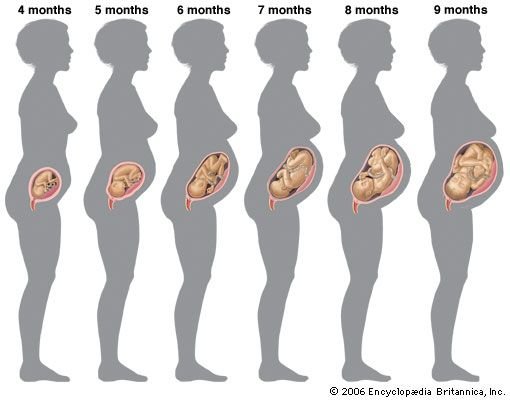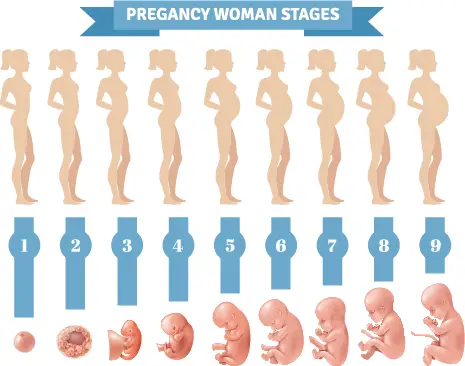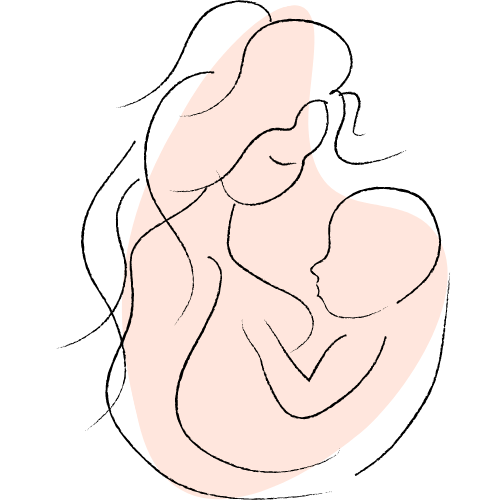From the very early stages to labor and delivery, use our month-to-month guide to learn what to expect along the way.
In the first 20 weeks, fetal growth is usually fairly consistent. In the second half of pregnancy, there is more variation based on genetics.
The first month of pregnancy
For the first few weeks of what is counted as your pregnancy, you’re not actually pregnant yet. This is the time between the first day of your last period and when you ovulate and conceive. Only a few women will even take a pregnancy test by the very end of this first month. The fertilized egg leaves the fallopian tubes and heads toward the uterus, where it will eventually implant. Its cells are rapidly dividing during this process. Once in the uterus, the placenta begins to form.

Second month of pregnancy
This month, your baby will become an embryo and the heart will begin to beat. Rudimentary structures will also begin to form, like buds that will become limbs and rays that will become fingers and toes. Your baby’s internal organs have all begun to form, including the brain and spinal cord. Because these crucial structures are developing at this time, it’s important to take a prenatal vitamin with folic acid to prevent some birth defects.
The third month of pregnancy
In the third month, you have probably begun to receive prenatal care. Your baby has more developed hands and moves about in the uterus, even though you can’t feel it yet. The fingers even have tiny, soft nails on them. Your baby’s skin is very thin, and you can see veins and other structures through it. If you have an ultrasound, you may also notice that the arms look longer than the legs — your baby’s upper body is more developed than its lower body at this point.

Fourth month of pregnancy
Welcome to the second trimester! Your baby’s arms and legs are really moving now — the elbows and knees are working. While the sex organs and genitalia have been forming already, only now are they externally visible. Around week 14, you might be able to learn the sex of your baby. Your baby’s kidneys also begin to produce urine, which helps make up the amniotic fluid that your baby swallows. The placenta is also fully formed. Your baby can even hear some sounds.
The fifth month of pregnancy
Your baby’s body is covered with a fine hair known as lanugo as well as a waxy coating called vernix that help protect your baby’s skin. This month, as your baby grows and becomes more active, you may begin to feel small movements. Did you know that your baby is also sleeping and waking on a regular basis? You may eventually notice patterns of movement that indicate waking and sleeping. If you are having a girl, she already has all the eggs in her ovaries that she will have in her lifetime.

The sixth month of pregnancy
Your baby can now open its eyes. The hair on its head begins to grow, though not all babies will have visible hair at birth. On the fingers and toes, the whirls that make up prints are forming. These are unique, even for identical twins. The baby’s lungs are also formed but not fully functional. Brain growth is also rapid at this point.
Seventh month of pregnancy
When your baby senses light through the uterus, it will open and close its eyes. You can really feel the kicks and stretches now. In fact, other people might be able to feel or see them too. The lanugo begins to disappear from the body. Your baby may be grasping and responding to sound. The baby’s lungs are making surfactant, which helps them stay expanded at birth.

Eighth month of pregnancy
You may notice a rhythmic thumping of your belly — hiccups! They don’t seem to bother the baby, and there isn’t anything you can do about it. The baby’s bones will ossify or harden, though the skull remains a bit softer and made up of four bones to allow for an easier delivery. Your baby can now taste sweet and sour thanks to working taste buds. At this stage, your baby is gaining weight more quickly.
The ninth month of pregnancy
Your baby’s skin looks less wrinkled as it gains a bit of weight, including brown fat. The brain has a huge growth spurt this month, which is why waiting for labor to begin on its own is best. Typically, your baby has been in a head-down position or will assume one as birth nears.
